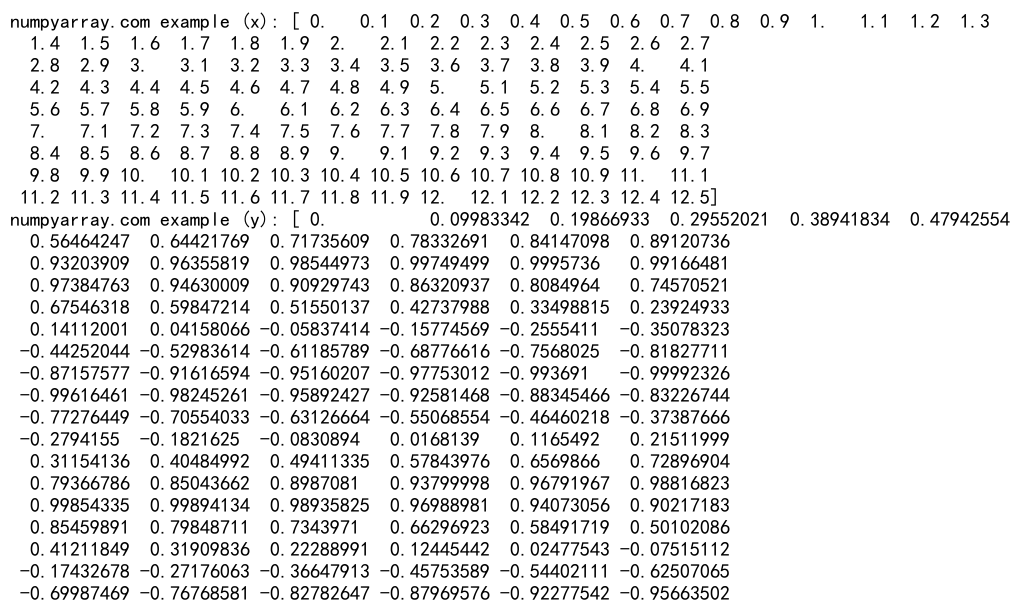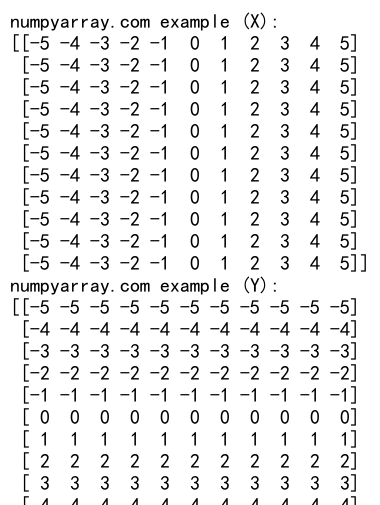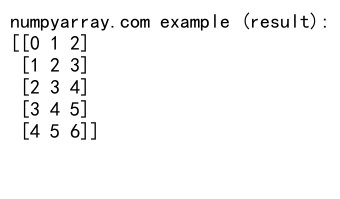NumPy arange函数:创建等差数列数组的强大工具
参考:
NumPy是Python中用于科学计算的核心库之一,它提供了大量用于处理多维数组和矩阵的工具。其中,arange函数是一个非常实用的工具,用于创建等差数列数组。本文将深入探讨NumPy的arange函数,特别关注其endpoint参数的使用,以及如何灵活地创建各种数值序列。
1. NumPy arange函数简介
numpy.arange函数是NumPy库中用于创建等差数列的函数。它可以生成一个一维数组,其中包含一系列均匀间隔的值。这个函数的基本语法如下:
numpy.arange([start,] stop[, step,], dtype=None)
其中:
– start:序列的起始值(可选,默认为0)
– stop:序列的结束值(不包含)
– step:序列中相邻元素之间的步长(可选,默认为1)
– dtype:数组的数据类型(可选)
让我们看一个简单的例子:
import numpy as np
# 创建一个从0到5的数组
arr = np.arange(6)
print("numpyarray.com example:", arr)
Output:

这个例子会创建一个包含[0, 1, 2, 3, 4, 5]的数组。注意,结束值5是不包含在内的。
2. 使用start和step参数
arange函数的灵活性体现在可以指定起始值和步长。这允许我们创建各种不同的数列。
import numpy as np
# 创建一个从2开始,到10结束,步长为2的数组
arr = np.arange(2, 11, 2)
print("numpyarray.com example:", arr)
Output:

这个例子会创建一个包含[2, 4, 6, 8, 10]的数组。注意,虽然我们指定了结束值为11,但实际上10是最后一个被包含的值,因为下一个值12已经超过了11。
3. 使用浮点数步长
arange函数不仅限于整数步长,它也支持浮点数步长。这在创建更精细的数列时非常有用。
import numpy as np
# 创建一个从0开始,到1结束,步长为0.1的数组
arr = np.arange(0, 1.1, 0.1)
print("numpyarray.com example:", arr)
Output:

这个例子会创建一个包含[0., 0.1, 0.2, …, 0.9, 1.]的数组。注意,由于浮点数精度的限制,最后一个值可能会略有偏差。
4. endpoint参数的作用
arange函数默认不包含结束值。但是,有时我们可能希望包含结束值。这就是endpoint参数发挥作用的地方。虽然arange函数本身没有endpoint参数,但我们可以通过一些技巧来实现类似的效果。
import numpy as np
# 创建一个从0到5的数组,包含结束值
arr = np.arange(6)
print("numpyarray.com example (without endpoint):", arr)
# 使用linspace来包含结束值
arr_with_endpoint = np.linspace(0, 5, 6, dtype=int)
print("numpyarray.com example (with endpoint):", arr_with_endpoint)
Output:

在这个例子中,我们使用了linspace函数来创建一个包含结束值的数组。linspace函数允许我们指定要生成的元素数量,从而可以精确控制是否包含结束值。
5. 处理浮点数精度问题
当使用浮点数步长时,可能会遇到精度问题。这是因为浮点数在计算机中的表示并不总是精确的。
import numpy as np
# 创建一个从0到1的数组,步长为0.1
arr = np.arange(0, 1.1, 0.1)
print("numpyarray.com example:", arr)
print("Length:", len(arr))
Output:

在这个例子中,你可能会发现数组的长度是11,而不是预期的10。这是因为最后一个值可能略大于1,由于浮点数精度的限制。
为了解决这个问题,我们可以使用round函数来四舍五入结果:
import numpy as np
# 创建一个从0到1的数组,步长为0.1,并四舍五入
arr = np.round(np.arange(0, 1.1, 0.1), decimals=1)
print("numpyarray.com example:", arr)
print("Length:", len(arr))
Output:

这个方法可以帮助我们得到更符合预期的结果。
6. 使用arange创建递减序列
arange函数不仅可以创建递增序列,还可以用于创建递减序列。只需要指定一个负的步长即可。
import numpy as np
# 创建一个从10到1的递减序列
arr = np.arange(10, 0, -1)
print("numpyarray.com example:", arr)
Output:

这个例子会创建一个包含[10, 9, 8, …, 2, 1]的数组。注意,结束值0不包含在内。
7. 结合reshape函数创建多维数组
arange函数生成的是一维数组,但我们可以结合reshape函数来创建多维数组。
import numpy as np
# 创建一个3x4的二维数组
arr = np.arange(12).reshape(3, 4)
print("numpyarray.com example:")
print(arr)
Output:

这个例子会创建一个3行4列的二维数组,其中包含0到11的数字。
8. 使用dtype参数指定数据类型
arange函数允许我们通过dtype参数指定生成数组的数据类型。这在需要特定数据类型的场景中非常有用。
import numpy as np
# 创建一个浮点数类型的数组
arr_float = np.arange(5, dtype=float)
print("numpyarray.com example (float):", arr_float)
# 创建一个复数类型的数组
arr_complex = np.arange(5, dtype=complex)
print("numpyarray.com example (complex):", arr_complex)
Output:

这个例子展示了如何创建不同数据类型的数组。注意复数类型数组的虚部都是0。
9. 使用arange创建时间序列
arange函数结合NumPy的datetime64类型,可以用来创建时间序列。
import numpy as np
# 创建一个日期序列,从2023-01-01开始,间隔为1天
dates = np.arange('2023-01-01', '2023-01-10', dtype='datetime64[D]')
print("numpyarray.com example:", dates)
Output:

这个例子会创建一个包含2023年1月1日到1月9日的日期序列。
10. 使用arange进行数学运算
arange函数创建的数组可以直接用于各种数学运算,这是NumPy的一个强大特性。
import numpy as np
# 创建一个数组并进行数学运算
arr = np.arange(1, 6)
squared = arr ** 2
print("numpyarray.com example (original):", arr)
print("numpyarray.com example (squared):", squared)
Output:

这个例子展示了如何对arange创建的数组进行平方运算。
11. 使用arange创建周期性数据
arange函数结合三角函数可以用来创建周期性数据,这在信号处理等领域非常有用。
import numpy as np
# 创建一个正弦波
x = np.arange(0, 4*np.pi, 0.1)
y = np.sin(x)
print("numpyarray.com example (x):", x)
print("numpyarray.com example (y):", y)
Output:

这个例子创建了一个正弦波的x和y坐标。
12. 使用arange进行数组索引
arange函数也可以用来创建索引数组,这在数组切片和高级索引中非常有用。
import numpy as np
# 创建一个数组
arr = np.array([10, 20, 30, 40, 50])
# 使用arange创建索引数组
indices = np.arange(0, 5, 2)
print("numpyarray.com example (original):", arr)
print("numpyarray.com example (indices):", indices)
print("numpyarray.com example (indexed):", arr[indices])
Output:

这个例子展示了如何使用arange创建的索引数组来选择原数组中的特定元素。
13. 结合arange和random函数
arange函数可以与NumPy的随机函数结合使用,创建具有特定范围的随机数据。
import numpy as np
# 创建一个范围内的随机整数数组
random_ints = np.random.randint(1, 101, size=10)
print("numpyarray.com example (random ints):", random_ints)
# 使用arange创建的数组作为概率分布
probs = np.arange(1, 11) / 55.0 # 概率和为1
random_choice = np.random.choice(np.arange(10), size=5, p=probs)
print("numpyarray.com example (random choice):", random_choice)
Output:

这个例子展示了如何使用arange创建概率分布,并用于随机选择。
14. 使用arange创建网格数据
arange函数结合meshgrid函数可以用来创建二维网格数据,这在绘图和数值计算中非常有用。
import numpy as np
# 创建x和y坐标
x = np.arange(-5, 6)
y = np.arange(-5, 6)
# 创建网格
X, Y = np.meshgrid(x, y)
print("numpyarray.com example (X):")
print(X)
print("numpyarray.com example (Y):")
print(Y)
Output:

这个例子创建了一个11×11的二维网格,可以用于绘制3D图形或进行二维数值计算。
15. 使用arange进行数组广播
NumPy的广播机制允许我们对不同形状的数组进行操作。arange函数创建的数组经常用于这种操作。
import numpy as np
# 创建一个列向量
col_vector = np.arange(0, 5).reshape(-1, 1)
# 创建一个行向量
row_vector = np.arange(0, 3)
# 进行广播操作
result = col_vector + row_vector
print("numpyarray.com example (result):")
print(result)
Output:

这个例子展示了如何使用arange创建的向量进行广播操作,得到一个5×3的矩阵。
结论
NumPy的arange函数是一个强大而灵活的工具,用于创建各种数值序列和数组。从简单的整数序列到复杂的多维数组,从时间序列到周期性数据,arange函数都能胜任。虽然它没有直接的endpoint参数,但通过结合其他函数如linspace,我们可以实现类似的功能。
在实际应用中,arange函数常常与其他NumPy函数和方法结合使用,如reshape、meshgrid等,以创建更复杂的数据结构。同时,它也可以与NumPy的数学函数和随机函数配合,用于各种科学计算和数据分析任务。
理解和掌握arange函数的各种用法,将大大提高你在NumPy中处理数组和进行数值计算的能力。无论是在数据科学、机器学习、信号处理还是其他科学计算领域,arange函数都是一个不可或缺的工具。
 极客教程
极客教程